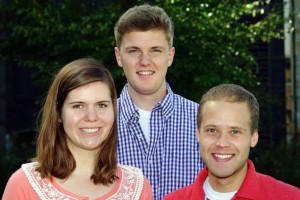Statistical applications in exercise science

Description: Students in the exercise science senior seminar class choose a research topic early in the fall semester. CIR students will advise and guide students in the design of a study and data collection procedure. By the end of the first semester, the exercise science students will have written an abstract, introduction, review of the literature, and a proposed methodology. Typically, at least three or four seniors continue with their projects (i.e., collect data) in order to achieve departmental distinction by the end of spring semester. CIR students will continue to advise students and in some cases participate in data collection. Together the exercise science students and the CIR Fellows will be involved in the data analysis during spring for those moving toward distinction. We are excited about the possibility of getting much more from our studies with the collaboration of the statistics students.
Domain Expert: Cindy Book (Exercise Science)
High information campaigning

Description: Political communication in electoral campaigns is a critical component to ensuring adequate representation and political accountability. While political scientists know a good deal about how candidates craft persuasive appeals, considerably less is known about the extent to which these appeals provide adequate information to inform the voting calculus. In other words, are candidates clearly spelling out their policy stances, or is rhetoric mired in ambiguity, mudslinging, and other types of language that might be less useful to voters. Moreover, little research has investigated the political/demographic conditions that promote higher (or lower) quality policy information. Under what circumstances (incumbency, competitive elections, campaign donations, level of education in districts, etc) are we most likely to see a “high information campaign?” Understanding these dynamics requires overcoming two main hurdles. First, using existing content analytic models, we need to develop an approach to measure the policy content of campaigns – essentially turning text into quantitative data. Specifically, we will be coding roughly 800 campaign websites for features ranging from specific mentions of legislation to ad hominum attacks to ambiguity. Second, we will be merging these campaign data with data from the census, the FEC, and the like, to model variance in high information campaigning as a function of political and demographic variables.
Domain Expert: Chris Chapp (Political Science)
The Effect of Multiple Chronic Conditions on Medical Mistakes

Description: This project essentially tries to identify the most problematic combinations of chronic conditions (such as diabetes, heart disease, asthma, depression, etc.) for the medical system to handle, and the hospital characteristics that predict good treatment for these patients. About a quarter of the population has multiple chronic conditions (such as diabetes AND asthma), and these patients account for over two thirds of the dollars spend on medical care in the US. However, the medical system is designed around specific illnesses and parts of the body. For example cardiology (heart care) and oncology (cancer care) have different departments within a hospital and different medical training for doctors specializing in each. Because the business of medicine is organized into silos, coordination of care for these complex patients can become a major barrier to good care. Medical mistakes account for between 180,000 and 440,000 patient deaths per year, and many more patient disabilities. The question is: does the system’s inefficiency at handling such complex patients contribute to these medical mistakes? If so, what combinations of chronic illnesses most increase the chance of medical errors? Also, what hospital characteristics are associated with an improved ability to handle patients with multiple chronic conditions? Finally Medicare (government insurance for the elderly) implemented a policy refusing to pay hospitals to treat conditions that were likely due to medical mistakes. If we have time, we can investigate the effect of this policy change on hospital care for patients with multiple chronic conditions.
Domain Expert: Ashley Hodgson (Economics)
STEM persistence, trajectories within major, and open questions of credit and curriculum at St Olaf College

Description: St. Olaf students who begin college in science courses take a wide variety of paths through college. Some stay in science, some switch between sciences, and others choose to major in something other than science. This summer students are investigating the course-taking trajectories of several groups and class years of St. Olaf students in an effort to begin to address several research questions:
- What is the demographic profile of St Olaf students over the last 10 years?
- Do 4-, 5- and 6-year graduation rates differ based on ACT score?
- Is number of AP credits associated with a Major in a STEM discipline?
- Is number of AP credits associated with number of 300-level courses taken by St. Olaf students?
Continuing this work into the academic year with CIR students, we hope to explore more in depth the following:
- In which courses do students begin their science education at St. Olaf?
- What effect does placement (either Advanced Placement or math or chemistry placement) have on student retention in science and how much science they take as an undergraduate?
- What courses are barriers to continuing in science? Is the decision to stop taking science classes performance (grade) based?
- Where do the students that choose to major in something other than science go?
- How do groups of courses cluster together?
- Would the use of latent variable modeling strengthen this analysis?
- How do the trajectories of SSS students compare to other groups?
Domain Expert: Mary Walczak (Chemistry, Associate Dean of NSM)
Dimensional Models for Understanding and Assessing Aspects of Compulsive Personality

Description: Scientists and clinicians in the mental health field have long been interested in maladaptive aspects of personality. However, research into pathological personality (i.e. personality disorders) has been largely disconnected from the advances in the field of general personality trait theory and research. One consequence of this divide is a very limited understanding of the hierarchical structure of pathological personality traits. For example, a higher-order trait named Compulsivity has been theorized to be comprised of common, maladaptive forms of the lower-order traits perfectionism, rigidity, orderliness, risk aversion, and persistence but there has been little empirical investigation of this proposal and the data that does exist has been mixed at best (e.g. Krueger, Eaton et al., 2011). A second consequence of the divide between fields of general personality and personality pathology has been a lack consensus regarding how “normal” and “abnormal” personality traits are connected to one another. Many theoretical and empirical models have been proposed and examined over the years in an attempt to bridge this gap. Perhaps the most prominent example of these efforts has been the extension of a model of “normal” personality, the Five Factor Model (FFM), for use in assessing and diagnosing personality pathology (e.g. Samuel & Widiger, 2008). Another notable example is the Personality Psychopathology Five (PSY-5; Harkness & McNulty, 1994), which was developed with the explicit purpose of creating a dimensional model encompassing both adaptive and maladaptive variations in personality traits.
In this project, we will use self-report data collected from college undergraduates to quantitatively examine in multivariate space two important theoretical questions in an attempt to build upon efforts to close the gap between adaptive and maladaptive aspects of personality. The data consist of responses collected from 400-600 college students administered several hundred questions about their own perfectionism, rigidity, orderliness, risk aversion, and persistence. Participants were asked about both adaptive and maladaptive aspects of these personality characteristics. Specifically, we will examine the higher-order structure of these traits and test their relationship to one another by pitting several competing theoretical models of this structure against one another. Next, we will attempt to examine how these traits are connected to two better established models of personality, the FFM and the PSY-5. Multivariate analysis (e.g. Structural Equation Modeling) will be utilized for both steps.
Domain Expert: Carlo Veltri (Psychology)
An Examination of the Decision to Major in Economics

Description: Recent research has shown that female and male students react differently to the grades they receive in introductory classes when deciding on courses of study. For example, a study by a Harvard economics professor found that women are discouraged from majoring in economics by low grades in the introductory course while men are not. At St. Olaf, where the female:male ratio is 3:2, the ratio is 2:3 among economics majors. Is the disparity the grade effect or is it related to a self-selection based on prior interest in the subject?
In this project, we will examine the decision to major in economics for students who completed the introductory course (Econ 121) in the past several years. To gauge students’ interest in the subject prior to enrolling, we will survey students in this year’s sections and use a proximity-matching algorithm to assign estimated interest scores to students in previous years’ classes. We will then construct and estimate several different models to examine the responsiveness of the decision to major to prior interest, grades in Econ 121, and gender.
Domain Experts: Rebecca Judge and Anthony Becker (Economics)
You must be logged in to post a comment.